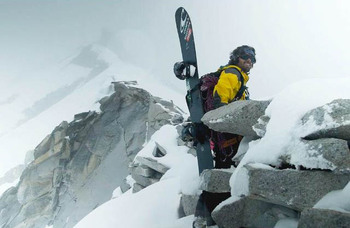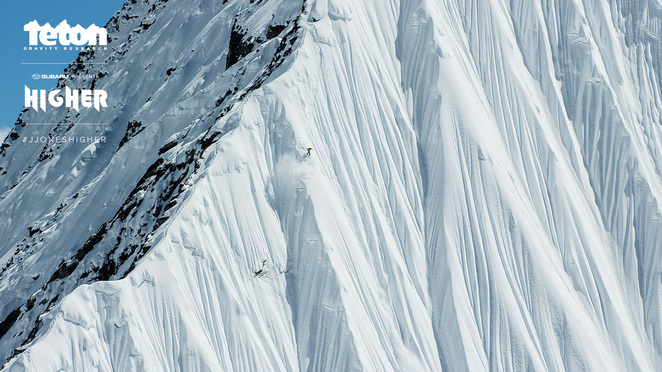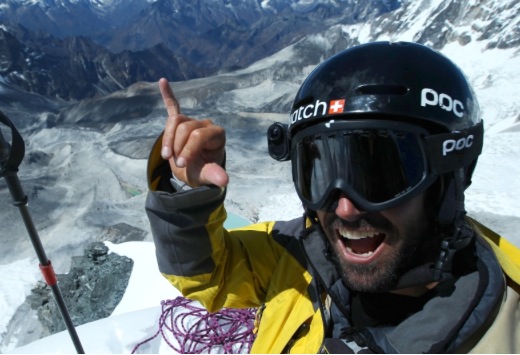 Jones climbing for turns (Photos courtesy Jeremy Jones)
Jones climbing for turns (Photos courtesy Jeremy Jones)
By Emily Wolfe
Jeremy Jones is one of the world’s foremost snowboard mountaineers, riding peaks from Alaska to the Himalaya, and founding Protect Our Winters, an influential nonprofit mobilizing the winter sports community in the fight against climate change.
While filming for Higher, the third in a series of Teton Gravity Research films about his progression as an athlete, Jeremy collected snow samples from 18,300 feet in the Himalaya for ASC’s Snow & Ice Project.
“One of [Jeremy’s] samples, the deepest sample from Ning Bu La Glacier, demonstrates a peak in radioactivity,” said ASC partner scientist Dr. Natalie Kerhwald, a glaciologist at the University of Venice. “This can only be caused by human activity.”
Jeremy Jones is one of the world’s foremost snowboard mountaineers, riding peaks from Alaska to the Himalaya, and founding Protect Our Winters, an influential nonprofit mobilizing the winter sports community in the fight against climate change.
While filming for Higher, the third in a series of Teton Gravity Research films about his progression as an athlete, Jeremy collected snow samples from 18,300 feet in the Himalaya for ASC’s Snow & Ice Project.
“One of [Jeremy’s] samples, the deepest sample from Ning Bu La Glacier, demonstrates a peak in radioactivity,” said ASC partner scientist Dr. Natalie Kerhwald, a glaciologist at the University of Venice. “This can only be caused by human activity.”
|
WATCH a film by TGR and Clif Bar ft. Jeremy Jones and ASC:
|
Looking for these radioactive isotopes is part of the process Dr. Kehrwald uses to date the samples. The isotopes found in his samples could be from United States thermonuclear bomb tests in 1952-56, Russian thermonuclear bomb tests in 1962-63, the Chernobyl incident in the 1980s, or the recent Fukishima incident, she explained.
From some samples, she can pinpoint a specific incident; by gauging snow and ice accumulation over top of that, she can measure if a glacier is thinning. After analyzing Jeremy’s samples, she reported what she called “a good-news take home message.”
|
“Ning Bu La Glacier is accumulating, as evidenced by the high concentrations of beta radioactivity,” Dr. Kehrwald said. “Since the snow that Jeremy was digging was soft, relatively fresh and relatively shallow, my hunch is that [it] reflects the Fukushima incident.”
 Jones drops in for the first time on Shangri-la Peak, Nepal. (Photo courtesy of Teton Gravity Research)
Jones drops in for the first time on Shangri-la Peak, Nepal. (Photo courtesy of Teton Gravity Research)
Q&A with Jeremy Jones
ASC: Why did you want to visit the Himalaya?
Jones: I had never really thought about snowboarding them until about six months before that trip, when I felt this pull to go check them out. It’s the Great Range—the biggest mountains in the world. My main cameraman man sent a photo of a beautiful face, and I thought there would be a chance I could snowboard it. It was an unclimbed peak we called Shangri-La.
ASC: What was the expedition like?
Jones: It took two weeks to get to base camp, and another week before I strapped my board on and made a run. Our base camp was at 16,500 feet, and our high camp was at 17,700 feet—while it wasn’t super far, we had to work our way up slowly. In week four, we got a high pressure, and I ended up going up the peak three times in four days. We left when one of the biggest monsoons in recent history came in.
ASC: What was the riding like?
Jones: I did a total of four runs. I had a mix of pretty good snow, soft equatorial powder, and then some edgeable sun-affected snow. I had no idea about snow conditions [before] the trip. I talked to climbers, and they always go in dry season. Everyone said it’s gonna be bulletproof. Our goal was to go at the end of the wet season and get soft snow, which is what we got.
ASC: Why did you want to participate in the ASC project?
Jones: Climate change is something I’m passionate about, which is why I started Protect Our Winters. When I heard I could be of help to climate scientists, I got really excited. I’m already going through the efforts to get to this far-off place. If I can help a scientist with that effort and with the snow samples we got, it’s a perfect scenario. I hope to do more of that.
ASC: What was data collection like?
Jones: Before doing it, I didn’t think anything of it—“Oh sure, we can dig a hole no problem and get samples.” With altitude when you’re walking, you can settle into a pace and it’s not that big of a deal, but as soon as you start doing more serious exercise, that’s when you really feel the effects. We took samples from two fingers of a glacier, and dug two pretty deep holes. They definitely took a long time—a group effort. I took the final sample the day I summitted and rode the peak.
ASC: What gave you the idea to found Protect Our Winters?
Jones: In my life of being in the mountains, I saw significant change and felt like the winter sports community needed to do something about it. I felt I had connections I could corral and hopefully get the industry to come together and protect our winters.
ASC: The organization has been really successful. Why do you think that is?
Jones: Thank you. We don’t have a lot of celebratory days at Protect Our Winters, but I think the support comes from skiers and snowboarders—they’re out there every day, and they see it. They detect climate change firsthand and don’t need to read a science report to be told that it is real, and they have a love for the mountains and want to help.
ASC: Why did you want to visit the Himalaya?
Jones: I had never really thought about snowboarding them until about six months before that trip, when I felt this pull to go check them out. It’s the Great Range—the biggest mountains in the world. My main cameraman man sent a photo of a beautiful face, and I thought there would be a chance I could snowboard it. It was an unclimbed peak we called Shangri-La.
ASC: What was the expedition like?
Jones: It took two weeks to get to base camp, and another week before I strapped my board on and made a run. Our base camp was at 16,500 feet, and our high camp was at 17,700 feet—while it wasn’t super far, we had to work our way up slowly. In week four, we got a high pressure, and I ended up going up the peak three times in four days. We left when one of the biggest monsoons in recent history came in.
ASC: What was the riding like?
Jones: I did a total of four runs. I had a mix of pretty good snow, soft equatorial powder, and then some edgeable sun-affected snow. I had no idea about snow conditions [before] the trip. I talked to climbers, and they always go in dry season. Everyone said it’s gonna be bulletproof. Our goal was to go at the end of the wet season and get soft snow, which is what we got.
ASC: Why did you want to participate in the ASC project?
Jones: Climate change is something I’m passionate about, which is why I started Protect Our Winters. When I heard I could be of help to climate scientists, I got really excited. I’m already going through the efforts to get to this far-off place. If I can help a scientist with that effort and with the snow samples we got, it’s a perfect scenario. I hope to do more of that.
ASC: What was data collection like?
Jones: Before doing it, I didn’t think anything of it—“Oh sure, we can dig a hole no problem and get samples.” With altitude when you’re walking, you can settle into a pace and it’s not that big of a deal, but as soon as you start doing more serious exercise, that’s when you really feel the effects. We took samples from two fingers of a glacier, and dug two pretty deep holes. They definitely took a long time—a group effort. I took the final sample the day I summitted and rode the peak.
ASC: What gave you the idea to found Protect Our Winters?
Jones: In my life of being in the mountains, I saw significant change and felt like the winter sports community needed to do something about it. I felt I had connections I could corral and hopefully get the industry to come together and protect our winters.
ASC: The organization has been really successful. Why do you think that is?
Jones: Thank you. We don’t have a lot of celebratory days at Protect Our Winters, but I think the support comes from skiers and snowboarders—they’re out there every day, and they see it. They detect climate change firsthand and don’t need to read a science report to be told that it is real, and they have a love for the mountains and want to help.
Emily Wolfe is ASC’s marketing and outreach manager. Find more about the ASC Snow and Ice project on our website, and learn more on the Field Notes blog, Facebook, Twitter, Instagram and Google+.


